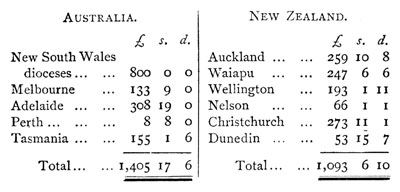For the information contained in this chapter the editor cordially acknowledges his indebtedness chiefly to the Ven. Benjamin Thornton Dudley, Archdeacon of Waitemata, and Treasurer of the Mission. He has made use also of a brief "letter from the Bishop of Melanesia to a former member of his staff," dated Nov. 19th, 1886:-
The Mission Field.--This includes, at the present time, 1. The three north-easternmost islands of the New Hebrides Group. 2. The Banks's Islands. 3. The Torres Islands. 4. The Santa Cruz group. 5. The Southern and Eastern Islands of the Solomon group. The mission has surrendered some of the central New Hebrides Islands to the Presbyterian Mission, as, in its first days, it surrendered the Loyalty Islands to the London Missionary Society.
The Mission Staff.--The appointment and consecration of the present Bishop, the Right Rev. John Richardson Selwyn, D.D. (Cambridge), have been fully dealt with in the foregoing history. He is assisted by the following clergy:--
1. English.--The Revs. Charles Bice and Arthur Brittain, of St. Augustine's College, Canterbury, the Rev. Richard Blundell Comins, of Hatfield Hall, [465/466] Durham, the Rev. John Palmer, the Rev. J. H. Plant, M.A., St. John's College, Cambridge, and the Rev. T. C. Cullwick. It is uncertain whether the Rev. A. Penny, who has recently published a work entitled, "Ten Years in Melanesia" (Wells Gardner), will resume his position as a member of the staff. The Rev. Dr. Codrington, late Fellow of Wadham College, Oxford, who so ably administered the diocese in the vacancy before the consecration of the present Bishop, has recently resigned and returned to England, in fulfilment of a promise given to his college, that under certain circumstances he would do so.
2. Native.--The Rev. George Sarawia and Henry Tagalad, priests; and the Revs. Alfred Lobu, Robert Pantutun, Maros Tamata, and Walter Woser, Deacons. Two others, the Revs. Edwin Sakelrao and Charles Sapibuana, have died in the course of the last three years. Another deacon, the Rev. Edward Wogale, is also dead. One more, the Rev. Mano Wadrokal, deacon, a former worker at Mota, Santa Cruz, and elsewhere, has gone back to his old home, Nengone, one of the Loyalty Islands, and is lost to the mission for the present.
Head Quarters of the Mission.--The mission removed from its old head-quarters at Kohimarama, near Auckland, to Norfolk Island, in the year 1866, an estate of 1,000 acres in that island having been purchased from Sir John Young (now Lord Lisgar), then Governor of New South Wales, to form a mission station. The station was named St. Barnabas, and there is situated St. Barnabas' Chapel, built as a memorial to Bishop Patteson.
[467] Statistics.--In the letter of the Bishop of Melanesia, above referred to, dated November 19th, 1886, the bishop says, "The following rough summary for the year 1886 will show how we stand now ":--In sixteen islands, which are named, the Schools amounted in all at that date to 69, the teachers numbered 156, the scholars 2,977. The number of adult baptisms for the year was 559. At the Norfolk Island School there were at that date 180 scholars, instructed by six white clergy and three laymen, besides several ladies, who give most efficient help. The bishop confirmed 36 persons at Ara in that year, who, he says, "were prepared by the native clergyman in charge, and seemed very much in earnest to renew their vows."
Churches.--The bishop writes as follows: Great pains are taken now to build suitable schools and churches. In the Banks' Islands they work in lime and stone. Last month I opened a church on the little reef island of Rowa, containing a population of twenty-nine souls, where the walls, seats, Communion Table and rails were all made in concrete. I also consecrated a new church at Halavo, in Florida.
Expenditure.--The expenses of the mission amount to about £6,500 per annum. This sum is required for the following purposes:--Stipends of clergy and other helpers. 2. Food and clothing for the scholars at St. Barnabas' mission station. 3. The mission vessel, with its auxiliary steam power. 4. Salaries of native teachers, amounting to about £600 per annum.
[468] MEANS OF SUPPORT.--The sources of revenue are threefold.
I. The Melanesian Mission Trust Fund, which produces about £1,000 per annum, the proceeds of landed and other investments derived from the original capital raised by subscription in England by Bishop Selwyn, Bishop Patteson's bequest, and other bequests and donations.
II. Offertories and Subscriptions.--Rather more than £2,000 per annum is received from subscriptions raised in England. In 1886, the amounts received from the Australian and New Zealand dioceses, being chiefly the proceeds of offertory collections, were as follows:--

III. Scholarships.--About seventy persons or parishes in England support scholars; others contribute to the support of particular schools, or the work in particular islands. Twenty-five scholars are supported by schools, or individual benefactors in New Zealand, and forty-six in Australia. The amount contributed annually towards the support of a scholar is understood to be £10.